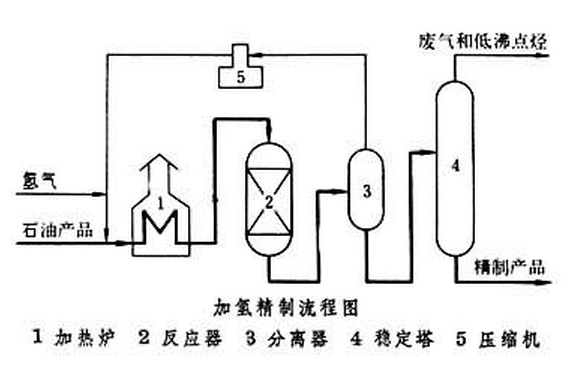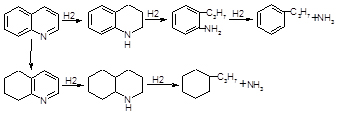Catalytic hydrogenation of Petroleum (petrochemicals)
Catalytic hydrogenation of petroleum refers to the catalytic processing of petroleum fractions (including residue) in the presence of hydrogen. Petroleum hydrogenation technology is an important means of refining, upgrading and heavy oil processing of petroleum products, which can reflect the level of refining. The hydrogenation process can be divided into:
HYDROFINING
The purpose of petroleum hydrofining is to remove sulfur, nitrogen, oxygen and other heteroatoms and metal impurities from oil products, and to hydrogenate and saturate some aromatic hydrocarbons or olefins to improve the performance of oil products.
Hydrofining can be used for refining gasoline, kerosene, diesel oil, lubricating oil, paraffin oil, various intermediate distillates, heavy oil and residual oil. In addition, hydrogen can also be used for partial hydrogenation saturation of aromatic hydrocarbons in jet fuel, hydrodesulfurization of fuel oil, heavy metal removal from residue and pretreatment of deasphalting. The process of hydrofining of various oils is basically the same (see figure). The feedstock is mixed with hydrogen and heated to a specified temperature in a heating tower and then into a fixed bed reactor with a catalyst. After the reaction is completed, the hydrogen is separated from the separator and circulates through the compressor. The product separates hydrogen sulfide, ammonia, water and gaseous hydrogen produced by a small amount of decomposition in the stabilization tower.

Refining principle:
1)Desulphurization
Thiol desulphurization:
Thioether desulphurization:
Two sulphide desulphurization:
Thiophene desulphurization: 
2)Denitrification
Amine denitrification:
Pyrrole denitrification:
Pyridine denitrification:
Indole denitrification:
Quinoline denitrification:
3)deoxidation
Deoxidation of naphthenic acid:
Phenolics deoxidization:
Furan deoxidization:
4)Hydrogenation saturation of olefin and Aromatics
Under hydrogenation conditions, most olefins react with hydrogen to form alkanes, and polycyclic aromatic hydrocarbons can be partially hydrogenated saturated.
5)Hydrodemetallic
The metal nickel and vanadium in the feed oil mainly exist in the form of porphyrin compounds and non-porphyrin compounds. The structures of these two compounds are very complex. In this macromolecular structure, not only metal but also sulfur and nitrogen impurities are contained. Hydrodemetallization involves the diffusion of residue molecules from the liquid phase to the catalyst surface, from the catalyst surface to the catalyst pore, adsorption to the active site, desorption of reaction products from the active site, diffusion from the catalyst pore to the catalyst surface, and diffusion from the catalyst surface to the liquid phase. So as to achieve the purpose of metal removal.
(2)Hydrocracking
1)Cracking of alkanes:
The general formula for hydrocracking of alkane can be expressed as:
2)Isomerization of alkanes:
Hydroisomerization of alkanes is the cracking and reforming of the molecular structure of the feedstock and the reorganization of the product molecular structure.
3)Olefin hydrogenation
Olefin hydrogenation is mainly the production of saturated alkanes and reforming isomerization. Macromolecular olefins can be further cracked to form small alkenes and then hydrogenated.。
4)Hydrogenation of aromatic hydrocarbons
Polycyclic aromatic hydrocarbons (PAHs) react step by step, first hydrogenate to cycloalkane aromatic hydrocarbons, then open the ring to monoalkyl aromatic hydrocarbons, and then react according to the monoaromatic hydrocarbon hydrocracking process. For example, benzene is hydrogenated to form six-membered cycloalkanes, then isomerized, reformed to ANHYDRIC cycloalkanes, pentamembered cycloalkanes are supported by ring-opening, or side chain breaks to form other hydrocarbons, the reaction formula is as follows. 
(3)Residue hydrotreating
Residue hydrotreating technology refers to the hydrotreating process in which a certain conversion reaction takes place under harsh conditions. China Petrochemical Co., Ltd., a subsidiary of Fushun Petrochemical Research Institute, has been exploring this technology since the mid-1980s. After more than ten years of efforts, China has finally developed its own new residue hydrotreating technology. The technologies include residue hydrodesulfurization, heavy distillate hydrodesulfurization, catalytic cracking feedstock and circulating oil hydropretreatment and intermediate distillate hydrotreating. The aim is to remove the toxic components (sulfur, nitrogen, heavy metals, etc.) from the raw materials, and to convert the residue with higher hydrocarbon ratio into the light components with lower hydrocarbon ratio and diesel oil.
(4)Lube oil hydrogenation
Hydrofining and hydrocracking reactions take place in the components of lubricating oils, which change the structure of some non-ideal components in order to remove heteroatoms and improve the performance of lubricating oils.